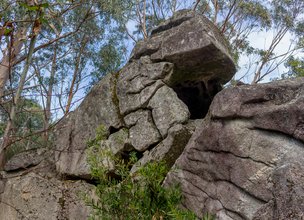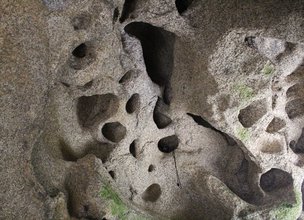Characteristics and evolution of tafoni
Rocks, when exposed to the action of water, air, and others, undergo a series of physical and chemical processes which modify their minerals. As a consequence, rocks become less cohesive and changes in their colour frequently take place. These series of transformations are called weathering. Rocks become more fragile and less cohesive after weathering and are dismantled by a process known as erosion. As a consequence, landforms of different scales arise
In rare circumstances that are not yet understood, rocks decay forming small cavities that look like a honeycomb. These cavities are called tafoni (word of Italian origin that means breach or window). Here, at Penedo Furado, the phenomenon is even more peculiar since tafoni have developed inside the granite block!
Penedo Furado is a granite block 7 m long, 3.5 m wide, 3.5 m high, and with an approximate volume of 55 m3 (Fig. 1). Its inner cavity corresponds to about 9 m3 of rock that has already been eroded, a process that is still going on.
The origin and development of this landform seem to be related to weathering, when a chemical process below the topographic surface took place, in association with the granite network of fractures (esqs. A and B).
The inside and top walls of Penedo Furado are entirely filled by small well individualized alveoli which sometimes coalesce giving rise to a typical form known as honey comb (Fig. 2).
The exposure of this landform results from the removal of the disaggregated overlying rock due to erosion, a process common to many granitic areas. Near the base of the tafone it is possible to identify the fallen block that initially held the cavity more isolated.
A little more about the origin of tafoni…
The origin and development of tafoni is still a subject of discussion in the scientific community, being attributed to various processes and mechanisms. However, it is already known that some originate due to the action below the surface of soil moisture on the rock. Alternatively, many tafoni appear to originate and develop at the surface due to weathering. The development / enlargement of the cavities originates from the inside of the tafoni, and may, in the limit, lead to the rupture of its outer “cover”. Variations in temperature, freezing and thawing of water and salt crystallization, among others, may be some of the factors responsible for cavities enlargement. Over time, the outer casing may even eventually rupture. In scheme C different stages of development of a tafone can be observed.
Rocks, when exposed to the action of water, air, and others, undergo a series of physical and chemical processes which modify their minerals. As a consequence, rocks become less cohesive and changes in their colour frequently take place. These series of transformations are called weathering. Rocks become more fragile and less cohesive after weathering and are dismantled by a process known as erosion. As a consequence, landforms of different scales arise
In rare circumstances that are not yet understood, rocks decay forming small cavities that look like a honeycomb. These cavities are called tafoni (word of Italian origin that means breach or window). Here, at Penedo Furado, the phenomenon is even more peculiar since tafoni have developed inside the granite block!
Penedo Furado is a granite block 7 m long, 3.5 m wide, 3.5 m high, and with an approximate volume of 55 m3 (Fig. 1). Its inner cavity corresponds to about 9 m3 of rock that has already been eroded, a process that is still going on.
The origin and development of this landform seem to be related to weathering, when a chemical process below the topographic surface took place, in association with the granite network of fractures (esqs. A and B).
The inside and top walls of Penedo Furado are entirely filled by small well individualized alveoli which sometimes coalesce giving rise to a typical form known as honey comb (Fig. 2).
The exposure of this landform results from the removal of the disaggregated overlying rock due to erosion, a process common to many granitic areas. Near the base of the tafone it is possible to identify the fallen block that initially held the cavity more isolated.
A little more about the origin of tafoni…
The origin and development of tafoni is still a subject of discussion in the scientific community, being attributed to various processes and mechanisms. However, it is already known that some originate due to the action below the surface of soil moisture on the rock. Alternatively, many tafoni appear to originate and develop at the surface due to weathering. The development / enlargement of the cavities originates from the inside of the tafoni, and may, in the limit, lead to the rupture of its outer “cover”. Variations in temperature, freezing and thawing of water and salt crystallization, among others, may be some of the factors responsible for cavities enlargement. Over time, the outer casing may even eventually rupture. In scheme C different stages of development of a tafone can be observed.
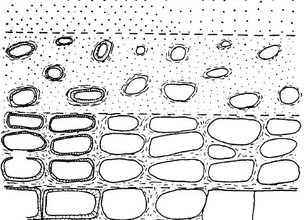
Esq. A - Typical granite weathering profile conditioned by fractures (Migon, 2006, after Ruxton and Berry, 1957).
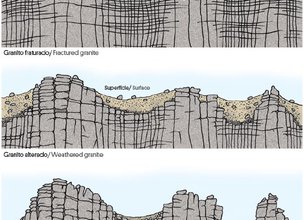
Esq. B - Evolution of granite landforms due to erosion.
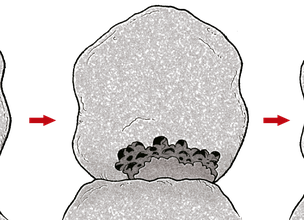
Esq. C - Development stages of a tafone.
Location
Monte da Meadela
Coordinates
Lat: 41.7211544
Long: -8.805648
Hello little one!
I'm Piquinhos and I can help you learn more about the Geopark!
Technical details
Esq. A - Typical granite weathering profile conditioned by fractures (Migon, 2006, after Ruxton and Berry, 1957).
Esq. B - Evolution of granite landforms due to erosion.
Esq. C - Development stages of a tafone.
Child Mode
Discover the geopark in a simpler format, aimed at the little ones.
Clique ENTER para pesquisar ou ESC para sair
